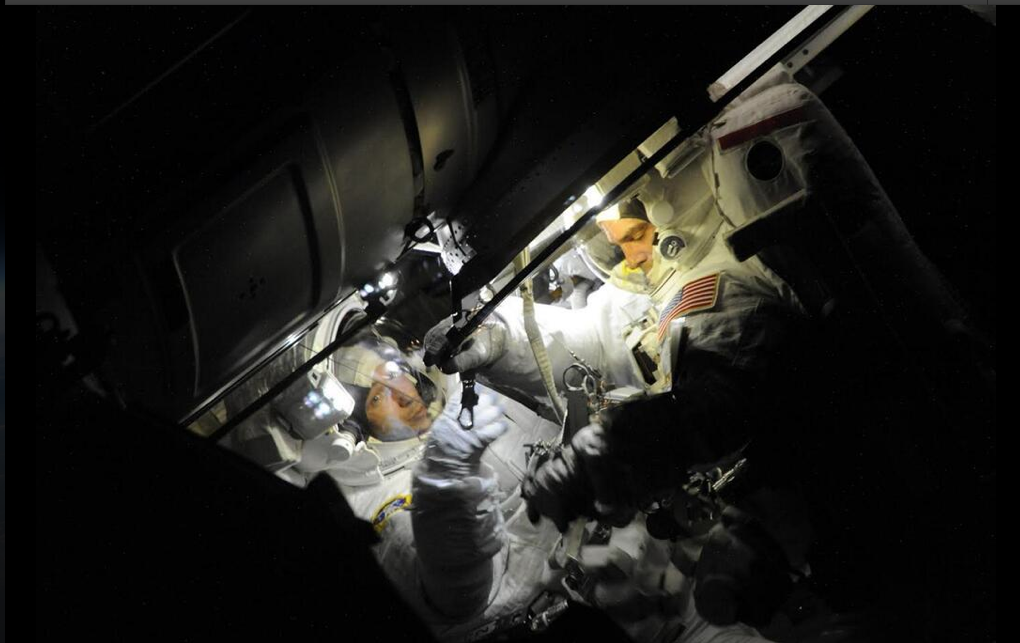
Photo Tweeted January 30, 2014 (during SSEP Crew Interaction Day 3) by U.S. Astronaut Rick Mastracchio (@AstrroRM). His caption: Night shot of our Christmas Eve EVA – Space is very dark but our helmet lights work great at short distances. CLICK ON PHOTO TO ZOOM
This is an update of on-orbit flight operations for the Student Spaceflight Experiments Program (SSEP) Mission 3b Falcon II and Mission 4 Orion experiments currently on the International Space Station. Crew Interaction Day 3 (of 6) occurred on schedule on Thursday, January 30, 2014. Crew interactions by astronaut Koichi Wakata were completed at 10:10 am ET.
Below is the NanoRacks communique received by the National Center for Earth and Space Science Education at 12:15 pm ET, January 30, providing the details of these on-orbit activities. The Center’s SSEP Flight Ops Manager, Stacy Hamel, then posted all details on the SSEP Mission 4 and 3b to ISS: Experiment Log page, and alerted all student flight teams by 1:16 pm ET. Details of activities on ISS were therefore communicated to flight teams 3 hours after they occurred.
Crew Interaction Day 4 (of 6) is scheduled for February 26, 14 days before undock (U-14d), de-orbit, and return to Earth of the SSEP experiment payloads aboard Soyuz 36S.
NanoRacks Communique
NanoRacks Module 9 S/N 1008, 1010, and 1011 Payload Science Status Report
Increment: 38
Mission Day: GMT 030
Originator: Rob Alexander
Date: January 30, 2014
Science Status: Koichi Wakata performed the following NanoRacks Mixuture Tube operations on orbit today. Operations were completed at 9:10 AM CST.
The following experiments were activated:
S/N 1008, Tube 8: The Effect of Microgravity on the Development of the Salamander
The following tubes were shaken:
S/N 1010, Tube 1: Mammalian Milk in Microgravity
S/N 1011, Tube 5: The Effect of Microgravity on the Oxidation of Metal Exposed to a Salt Water Solution
More information about these experiments can be found at the following link:
http://ssep.ncesse.org/communities/experiments-selected-for-flight/selected-experiments-on-ssep-mission-3-to-iss/
http://ssep.ncesse.org/communities/experiments-selected-for-flight/selected-experiments-on-ssep-mission-4-to-iss/
Unexpected Events: N/A
Science Look Ahead: The next crew interaction will be fourteen days before undock, on GMT 057 (February 26). The following tubes will be activated:
The following experiments will be activated:
S/N 1008, Tube 5: Geotropism in Microgravity
S/N 1008, Tube 6: The Effect of Microgravity on Bacterial Growth and its Resistance to Antibiotics
The following experiment will be deactivated:
S/N 1010, Tube 3: Does microgravity affect the growth of a Glycine max plant?
The following tubes will be shaken:
S/N 1010, Tube 1: Mammalian Milk in Microgravity
S/N 1011, Tube 5: The Effect of Microgravity on the Oxidation of Metal Exposed to a Salt Water Solution
The Student Spaceflight Experiments Program (SSEP) is a program of the National Center for Earth and Space Science Education (NCESSE) in the U.S., and the Arthur C. Clarke Institute for Space Education internationally. It is enabled through a strategic partnership with NanoRacks LLC, working with NASA under a Space Act Agreement as part of the utilization of the International Space Station as a National Laboratory. SSEP is the first pre-college STEM education program that is both a U.S. national initiative and implemented as an on-orbit commercial space venture.
The Smithsonian National Air and Space Museum, Center for the Advancement of Science in Space (CASIS), and Subaru of America, Inc. are National Partners on the Student Spaceflight Experiments Program.

Comments are closed.